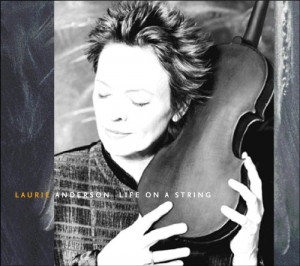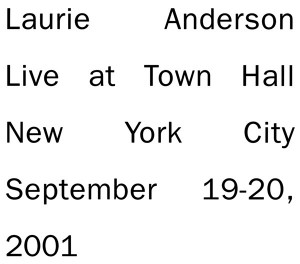 Cue the tape loop. A gentle female voice, almost human, sets up a rhythm, “ah ah ah ah … “. A violin, amplified, scratches. Then a melody finds its way out of the midst. You can imagine a blank canvas, in the dark … then a dim light illuminates a spot in the middle of this canvas. A person steps out of the darkness, into this pinpoint of light. Drums pick up the rhythm. What is that sound (I almost said noise) that fills the space? The person, dressed in a pant suit, is thin, and beautiful in a fragile, pointy way. She begins to speak, telling a story about a trip to Japan. Or two brothers from West Virginia with the same name, did they fall into a black hole? Her voice is fragile, soft, but pointy too. This could be Laurie Anderson.
Cue the tape loop. A gentle female voice, almost human, sets up a rhythm, “ah ah ah ah … “. A violin, amplified, scratches. Then a melody finds its way out of the midst. You can imagine a blank canvas, in the dark … then a dim light illuminates a spot in the middle of this canvas. A person steps out of the darkness, into this pinpoint of light. Drums pick up the rhythm. What is that sound (I almost said noise) that fills the space? The person, dressed in a pant suit, is thin, and beautiful in a fragile, pointy way. She begins to speak, telling a story about a trip to Japan. Or two brothers from West Virginia with the same name, did they fall into a black hole? Her voice is fragile, soft, but pointy too. This could be Laurie Anderson.
The tape loop continues. Wolves howl. No, it’s her taped voice. No, live but processed. Ms. Anderson was born in Chicago. It was 1947. She’s older than me. One of eight children, she learned to play the violin and played in the Chicago Youth Symphony. In 1969 she graduated from Barnard College, and then attended Columbia, attaining a graduate degree in sculpture. She taught Egyptian Studies, somewhere, I read. She became one of those, you know, performance artists. Doing her thing on the street, or in available rooms. They tell of her standing on a block of ice, wearing skates, playing her violin, ’til the ice melted. Then it was over. She continues to live in New York City. Her performances have … grown.
In 2000 Ms. Anderson prepared a stage show based on Moby Dick. No recorded version was released, but some of the songs found their way onto the 2001 album Life On A String. “One White Whale” is the first song on this, her first Nonesuch recording. It is Ahab, “How to find you maybe by your singing / a weird trail of notes in the water / one white whale in all these oceans / one white whale.” The music as haunted as Ahab’s soul. “The Island Where I Come From” is a sort of reggae if it was played by a jazz band. Syncopated, strong bass, sax, tumpet, handclaps and what is called ‘little organ’ … and Ms. Anderson’s voice. How to describe that voice. Precise. Gentle. Clear. Nearly emotionless, except when she wants to make a point. Her enunciation is specific, her phrasing … odd. Timed. The way she wants it. “Pieces and Parts” tells the story of the discovery, in 1842, on an Alabama plantation, of the skeleton of a giant whale. The slaves who found it thought it to be the remains of an angel. A fallen angel.
The instruments are played, on Life On A String, by Ms. Anderson (violin), Eric Friedlander (cello) and Skuli Sverrisson (bass). The instrumental “Here With You” is moody and evocative. They are joined by Joey Baron on drums for some tracks. Guest players include Hal Wilner (samples), Litheng (baritone banhu), Mitchell Froom (Mellotron, Wurlitzer) and others. Bill Frisell plays guitar on “Washington Street” and Van Dyke Parks provides keyboards and the creative, romantic, string arrangement for “Dark Angel.” Yes, angels, whales and New York City. This is Laurie Anderson’s world. This album came out on August 21, 2001. Within a couple of weeks the world changed.
(Nonesuch, 2001)
 Two weeks after 9/11 Laurie Anderson played a concert at Town Hall. The stories she told, the songs she sang took on a new resonance. Live at Town Hall New York City September 19-20 2001 is a 90-minute souvenir of that show. The truth is that many songs, well known songs, old songs, took on new meaning after 9/11. Just as Beth Neilsen Chapman’s version of Paul Simon’s “An American Tune” gave new meaning to ” … And I dreamed I was flying … ” so too does the announcement of the arrival of planes, ” … American planes … ” in Ms. Anderson’s rendition of “O Superman.”
Two weeks after 9/11 Laurie Anderson played a concert at Town Hall. The stories she told, the songs she sang took on a new resonance. Live at Town Hall New York City September 19-20 2001 is a 90-minute souvenir of that show. The truth is that many songs, well known songs, old songs, took on new meaning after 9/11. Just as Beth Neilsen Chapman’s version of Paul Simon’s “An American Tune” gave new meaning to ” … And I dreamed I was flying … ” so too does the announcement of the arrival of planes, ” … American planes … ” in Ms. Anderson’s rendition of “O Superman.”
The “ah ah ah” rhythm loop must still be playing as we consider this. Turn the lights off in the room while you read Green Man today. Let the glow of your monitor warm and illumine you. Ms. Anderson discusses the prophetic aspect of her story-songs in a brief liner note, which is inserted rather clumsily into the package. She denies the prophet’s role and claims that the war, which existed during the Iran-Contra Affair when she wrote the song, is the same war being fought today. “Loss, betrayal, death, technology, anger and angels, these have often been the things [she has] written about. At Town Hall [she] was singing for once about the absolute present.”
These songs, and the stories they tell are timeless, and contemporary. Originally, this concert was to be a live version of the Life On A String album, but in consultation with Lou Reed it became as close to a greatest hits show as one could ever imagine from Ms. Anderson. The band consisted of Skuli Sverrissen on bass and concertina, Jim Black on drums and electronic percussion and Peter Scherer on keyboards and samplers. Laurie Anderson played violin and keyboards. Be aware that there was a multi-media presentation accomanying the performance. ” … ah ah ah ah … ”
Live, the songs are even more compelling, Ms. Anderson’s voice even more human, and fragile. But you must realize there is a Midwestern toughness behind that fragility. Added to that, years of experience as a New Yorker. This is no pushover. But I could listen to her talk for hours. I have several of the older Warner Brothers albums, including the live multi-volume United States 1-4 which still resonate. The versions of “Let X=X,” “Sweaters,” and “O Superman” are every bit as haunting as I remember them. “White Lily” from Home of the Brave, “Strange Angels,” “Poison,” and “Coolsville” from Empty Places and “Love Among the Sailors” and “Puppet Motel” from Stories From the Nerve Bible fit seemlessly with the new material as performed by this band.
Spike walked in while Live … was playing. “D’you actually LIKE this #$*#?” he inquired. “Sweaters” was playing, a bit cacophonous for 9:30 in the morning. “It’s not all like this,” I replied. No indeed. Much of it is extremely mellow. Melodies seems to appear from nothing. Ideas and images abound. This is music that makes you think. And yet, the persuasive tones of her voice, the persistent gentle rhythms of inherent percussion, and the professional contributions by a superb band combine to provide an essential listening experience. If you are not familiar with Laurie Anderson’s work, this powerful live album and the studio work which preceded it make wonderful starting points.
The “ahs” fade to a simple tone. The lights, which have expanded to brighten the entire canvas, now dim to black. The sound of two hands clapping. Then footsteps into the night.
(Nonesuch, 2002)
